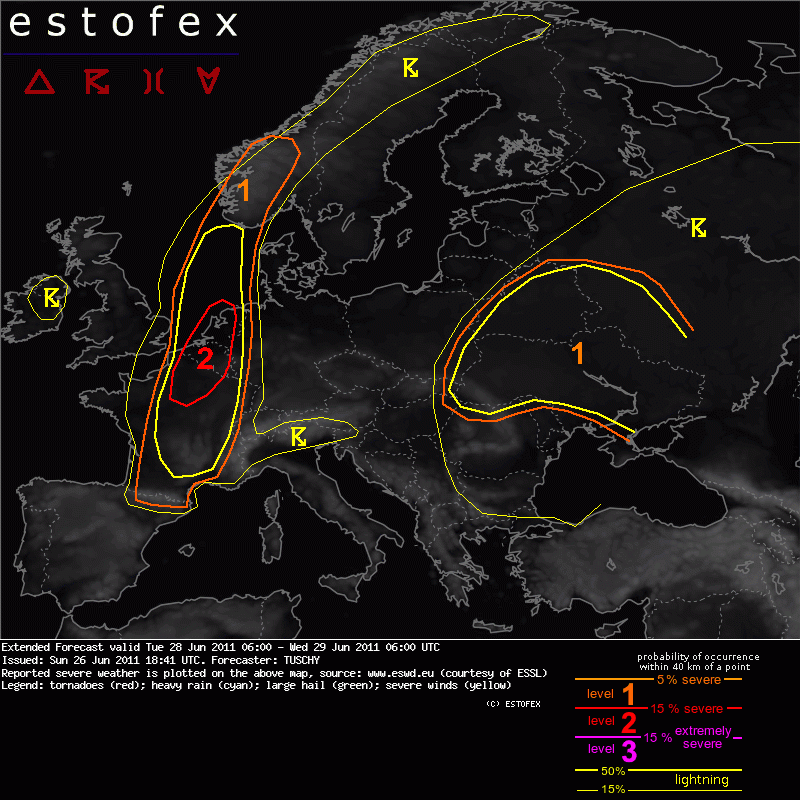
26-06-2011 18:41 | Estofex | m.b.t. 28-06-2011 t/m 29-06-2011

Extended Forecast
Valid: Tue 28 Jun 2011 06:00 to Wed 29 Jun 2011 06:00 UTC
Issued: Sun 26 Jun 2011 18:41
Forecaster: TUSCHY
A level 2 was issued for NE-France, Belgium and the Netherlands mainly for large to very large hail (>5 cm in diameter) and severe to damaging wind gusts.
A level 1 runs from extreme NE-Spain all the way to Norway mainly for large to isolated very large hail, strong to severe wind gusts and excessive rainfall.
A level 1 was issued for E-Poland/Slovakia/Hungary, Belarus and extreme W-Russia mainly for isolated large hail/severe wind gusts and tornado reports. Later-on an excessive rainfall risk will be present.
A level 1 was issued for parts of the Ukraine mainly for an isolated tornado event.
SYNOPSIS
An extensive upper trough over Ireland, Scotland and UK moves slowly eastwards during the forecast with a weakening downstream ridge present over parts of central Europe. An active cyclonic vortex over SE-Europe reveals a slight retrograde movement to the west with widespread showers and thunderstorms forecast.
DISCUSSION
... The Netherlands, Belgium, Luxembourg and parts of France ...
Upper-level forcing will be quite weak with a neutral tilted trough over the UK. Some model discrepancies concerning eastward progression remain with GFS the faster one in contrast to EZ, CMC and NOGAPS. However all models despite NOGAPS agree in scattered to widespread initiation along a slowly eastward moving cold front, which crosses the highlighted areas during the forecast from west to east. Also, the right entrance of a 40 m/s 300 hPa jet overspreads the region with additional high-level divergence. Hence, widespread initiation seems likely. FNMOC EFS and NCEP ENS mean (QPF) both agree well in highest precipitation probabilities over the S-North Sea with decreasing values over Benelux and E-France....but still augmented enough for high confidence for initiation along the eastward moving cold front. A final uncertainty arises with GFS/WRF, which develop a weak depression over Benelux, which could regionally enhance the wind field somewhat. This potential feature has to be followed closely in future model runs.
Prefrontal air mass over Benelux and E-France is characterized by rich moisture in the lower troposphere with 925 hPa dewpoints around 18°C and surface Tds in excess of 20 °C. Atop, EML fans out over the area of interest with decreasing mid-level lapse rates, but vertical temperature decrease remains strong enough for abundant CAPE build-up. While whopping 4000 J/kg MLCAPE of GFS seems unlikely, we expect 1000 to 2000 J/kg MLCAPE over the level 1 area with up to 3000 J/kg MLCAPE next to the surface boundary, where moisture pooling will be maximized (e.g. level 2 area). EZ agrees well with that scenario.
Shear remains weak over E-France but increases to 15-20 m/s 0-6 km DLS over central/NE-France and Benelux. Same with 0-3 km shear. Again, potential development of a weak surface depression over Benelux may modify kinematic environment.
Rapid to explosive thunderstorm development along the eastward moving cold front is forecast. Over central/E-France, thunderstorms will probably organize into multicells with severe downbursts and large to very large hail, especially when they remain more discrete for a longer period of time. Main concern arises over NE-France and Benelux, where indices for strong cold pool development exist. In addition, strong unidirectional shear will be present, so rapidly developing thunderstorms are forecast, which tend to line-up. Large to very large hail (> 5 cm hail in diameter) and severe wind gusts are expected. Betimes, bowing segments with swaths of severe to damaging wind gusts may evolve. Multiple rounds of severe weather are possible as thunderstorms from central France also move in during the late evening hours and onwards. Despite weak forcing and the possibility of rapid thunderstorm clustering, we think a scarce SWODY-2 level 2 is justified for this set-up, given augmented probabilities for damaging hail.
... Norway and parts of Sweden ...
Unstable air mass spreads northeastwards ahead of the major upper trough and also affects most parts of Norway. 200-500 J/kg MLCAPE and 15-20 m/s DLS overlap, so multicells are expected with large hail and severe wind gusts the main risk. No level was yet issued for that activity, as thermodynamics may be too marginal. Later data has to be evaluated for a potential upgrade.
During the evening and night hours, large thunderstorm clusters from the activity further to the southwest may affect S-Norway with heavy rainfall the main hazard. A level 1 was issued for that activity.
... Belarus and eastwards, extreme E-Poland/Slovakia/Hungary, Ukraine ...
A quasi-stationary /marginal westward moving upper low advects a moist and warm air mass westwards, affecting Belarus and parts of extreme W-Russia during the forecast. Roughly 800 J/kg MLCAPE and 15-20 m/s DLS overlap with mutlicells/isolated supercells forecast. Large hail and severe wind gusts accompany those thunderstorms with an enhanced tornado risk during the evening hours, as LL shear/SRH-1 increase. A concentrated outbreak of organized convection is possible over extreme E-Poland, W-Ukraine, SW Belarus and E-Slovakia/Hungary, if GFS 06Z/12Z scenario verifies. During the evening hours, numerous clusters may be ongoing with an augmented chance for training thunderstorms (excessive rainfall well possible).
Also, BL shear (speed/directional) over the Ukraine will be supportive for a few tornado reports as roughly 500 J/kg MLCAPE evolve. However, the overall tornado risk depends heavily on the final strength of the surface depression.
Hagel(-schade) | Onweer/blikseminslag | Verwachtingen/waarschuwingen | Wateroverlast/(zware) neerslag | Wind/storm (-schade)